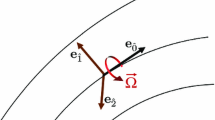Abstract
Newtonian and Machian aspects of the stationary gravitational field are brought into formal analogy with a stationary electromagnetic field. The electromagnetic vector potential equals (up to a factor) the timelike Killing vector field. The current density is given by the contraction of the Killing vector with the Ricci tensor. A coordinate-dependent split in electric and magnetic field vectors is given, and some results of classical electrodynamics are used to illustrate the analogy. In the linearized theory, the usual Maxwell equations are obtained. The analogy also holds from the point of view of particle motion. The geodesic equation is brought into a special form that exhibits an analog to the Lorentz force. Two examples (which have played an important role in the theoretical discovery of Machian effects) are considered.
Similar content being viewed by others
References
S. W. Hawking and G. F. R. Ellis,The Large-scale Structure of Space-time (Cambridge Univ. Press, Cambridge, 1973), p. 43.
L. Landau and E. Lifshitz,The Classical Theory of Fields (Addison-Wesley, London, 1971), p. 318.
R. Geroch,J. Math. Phys. 12, 918 (1971).
C. W. Misner, K. S. Thorne, and J. A. Wheeler,Gravitation (Freeman, San Francisco, 1973).
H. Weyl,Ann. Phys. 54, 117 (1917).
K. S. Thorne, Relativistic Stars, Black Holes, and Gravitational Waves, inProceedings of the International School of Physics “Enrico Fermi,” B. K. Sachs, ed. (Academic Press, New York, 1971), p. 256.
H. Thirring,Phys. Z. 19, 33 (1918).
H. Thirring,Phys. Z. 22, 29 (1921).
J. Lense and H. Thirring,Phys. Z. 19, 156 (1918).
D. R. Brill and J. M. Cohen,Phys. Rev. 143, 1011 (1966).
J. M. Cohen and D. R. Brill,Nuovo Cimento 56, 206 (1968).
R. O. Hansen,J. Math. Phys. 15, 46 (1974).
F. J. Ernst,Phys. Rev. 167, 1175 (1968).
D. Kramer, H. Stephani, E. Herlt, and M. MacCallum,Exact Solutions of Einstein's Field Equations (Cambridge Univ. Press, Cambridge, 1980), p. 184.
R. P. Kerr,Phys. Rev. Lett. 11, 237 (1963).
R. H. Boyer and R. W. Lindquist,J. Math. Phys. 8, 265 (1967).
R. Geroch,J. Math. Phys. 13, 956 (1972).
A. Komar,Phys. Rev. 113, 934 (1959).
R. O. Hansen and J. Winicour,J. Math. Phys. 16, 804 (1975).
R. Arnowitt, C. Deser, and C. W. Misner, “The Dynamics of General Relativity,” inGravitation, L. Witten, ed. (Wiley, New York, 1962).
R. Beig,Phys. Lett. A 69, 153 (1978).
J. D. Jackson,Classical Electrodynamics (Wiley, New York, 1962), p. 139.
R. D. Greene, E. L. Schucking, and E. V. Vishveshwara,J. Math. Phys. 16, 153 (1975).
J. M. Cohen,Phys. Rev. 173, 1258 (1968).
Author information
Authors and Affiliations
Rights and permissions
About this article
Cite this article
Embacher, F. The analog of electric and magnetic fields in stationary gravitational systems. Found Phys 14, 721–738 (1984). https://doi.org/10.1007/BF00736618
Received:
Issue Date:
DOI: https://doi.org/10.1007/BF00736618



